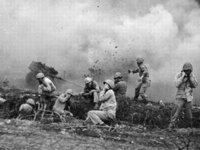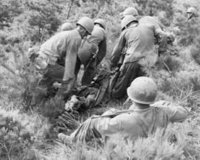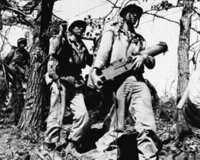 |
||||
 |
||||
Gene Dixon Memoir |
||||
|
||||
Send in the "Fire Brigade" |
||||
PART TWO |
||||
| Story by Maj Allan C. Bevilacqua, USMC (Ret) Photos courtesy of Marine Corps Historical Center Copyright Marine Corps Association Aug 2000 |
||||
|
The battles for Hills 342 and 255 on 7 and 8 Aug. 1950 had neutralized the North Korean threat to the vital main supply route. The Marine and Army forces were free to launch their drive toward the important communications center of Chinju along a dual axis. The Army's 5th Regimental Combat Team would drive for Chinju, 25 miles away along the northern route, through Tosan and Pansong. The Marines would form the southern prong of the attack, taking the southern route, longer by 17 miles, through Paedun-ni, Losong and Sachon.
Leading the 1st Provisional Marine Brigade's advance was Lieutenant Colonel George R. Newton's 1st Battalion, Fifth Marine Regiment. Newton's first objective was a massive terrain feature identified as Hill 308 that dominated the road from the east. The morning of 9 Aug. found Captain John Tobin's Company B clawing its way up the sheer sides of the hill that rose 1,000 feet above the surrounding terrain. Enemy resistance was confined to long-range sniper fire.
The resistance from the sun more than made up for the lack of enemy opposition. As the temperature soared to 115 degrees, more and more of Co B's Marines fell in their tracks to lay unconscious on the ground. Nevertheless, by noon the hill was entirely in Marine hands, although the cost had been ruinous. As the sun continued to blaze down, Co B could muster barely more than 30 men still on their feet. The remainder lay where they fell. No one had the strength to move them. Dusk brought blessed relief and best of all a party of Korean laborers with a supply of water. That didn't keep 15 of the worst heat casualties from having to be evacuated for medical treatment.
With the commanding height firmly in friendly hands, Brigadier General Edward A. Craig, the commander of the Marine brigade, ordered the 5th Marines to conduct a night attack to secure Paedun-ni before daylight on 10 Aug. The regimental commander, LtCol Raymond L. Murray, gave the job to his 2d Bn, led by LtCol Harold Roise. On schedule, Roise's men passed through 1/5 at 0115 on 10 Aug. and entered the undefended town at 0800. "Push on" was the word. By 0930, 2/5 was driving south again, this time in style. Regiment had sent a number of 21/2-ton trucks forward, and a shuttle system was started. Leading the parade was a detachment of the brigade's reconnaissance company, headed by Capt Kenneth Houghton.
It is an article of faith among Marines that something will always ruin a good deal. In this case something was a long defile called Taedabok Pass that squeezed both sides of the road as it rose upward about 21/2 miles below Paedun-ni. It was a good place to make a stand, and the North Korean rear guard did just that, hoping to buy a bit of time for the main body of the retreating 6th Division.
It happened suddenly. At 1500 the lead elements of the column came under heavy machine-gun fire. Then an antitank gun added its bark to the din, blowing one of the reconnaissance jeeps into a fireball. Marines piled out of vehicles and into ditches as bullets raked the roadway. Down went the redoubtable Master Sergeant Harold Reeves, shot through both legs. "Well, the sons of bitches finally got me," he grumbled.
Capt Andrew Zimmer, now commanding Co D, wasted no time sending his 1st and 2d Platoons up into the high ground to root out the defenders. Both platoons made short work of the squad-sized units in the immediate vicinity and settled in to exchange fire with the main body of the North Korean force farther up the pass. The company's 60 mm mortars put an end to the nuisance of the antitank gun but, in the process, exhausted their meager supply of ammunition. About then a pair of Marine M26 tanks arrived on the scene. A volley of high-velocity 90 mm shells sent the enemy to the ground. It was becoming apparent, though, that a sizable body of North Korean infantry was blocking the far end of the pass.
Directly in trace of 2/5 was LtCol Robert Taplett's 3/5. Murray promptly ordered Taplett to pass through 2/5 and continue the attack. To Private First Class Fred Davidson, a Co G rifleman in First Lieutenant Jack Westerman's platoon, it all happened a bit more personally. He found himself in a ditch with a very persistent North Korean sniper taking an intense interest in him.
"Each time I tried to move forward, the sniper put a round close enough to me to change my mind," Davidson said.
With Westerman's platoon held up by intense fire, Co G's commander, 1stLt Robert "Dewey" Bohn, sent Second Lieutenant Edward Duncan's platoon on a sweeping envelopment to the right to relieve the pressure on Westerman. The tactic was successful, as Duncan's men drove off the North Koreans opposing them with a blizzard of rifle and Browning Automatic Rifle fire. No longer pinned down, Westerman was able to move forward to the crest overlooking the north side of the roadway.
From his vantage point Westerman could see a Marine jeep in the roadway below. There were Marines, some dead, some wounded, on the ground beside and behind the shot-up vehicle. They were members of a patrol taken forward earlier by 2/5's operations officer, Major Morgan J. McNeely. Ignoring the danger, Westerman, known affectionately to his men as Big Jack, dashed down to the road, slung the badly wounded McNeely over his shoulder and sprinted back to safety. PFC Davidson gave the semiconscious McNeely a drink from his canteen and helped carry him to the battalion aid station. Westerman's and Davidson's gestures would be for naught. McNeely died during the night.
As darkness fell, Capt Joseph Fegan's Co H came up to seize the hills on the left side of the road, directly across from 1stLt Bohn's Co G. Both companies became engaged in a duel with two North Korean machine guns, and it was nearly full dark before the guns were silenced. At 2015, orders came from regiment for 3/5 to hold its positions for the night and prepare to continue to attack toward Kosong in the morning.
|
|
Dawn had no sooner begun to lighten the eastern horizon on 11 Aug. than a platoon-sized North Korean force charged out of the low ground fog and launched a frenzied attack on Co G's positions. It was a desperation effort, but for a while it made things interesting.
Shouting, firing burp guns and hurling grenades, the attackers charged right for Bohn's command post in the center of Co G's position. Marines met them in a hand-to-hand melee. A grenade fragment caught Bohn in the shoulder, but he continued in action. Beside him, Staff Sergeant Charles Kurtz directed a deadly fire from the company's 60 mm mortars while flinging a shower of grenades into the midst of the charging North Koreans.
It was over in 30 minutes. Thoroughly battered, the North Koreans fled in disarray in the direction of Kosong.
Hot on their heels came the entire Marine brigade, 3/5 in the lead with Co G forming the advance party. At the very tip of the spear was Corporal Ray Giaquinto's fire team out of 2dLt John Counselman's 3d Plt. A North Korean machine gun tried to impede the flow, but Giaquinto deployed his men before the enemy machine-gunners could react. All five of the North Koreans died without getting off a shot. Utilizing the same flanking tactics, Giaquinto's point swept aside three more North Korean positions, leaving nothing but dead bodies in its wake.
By 1000 the advance had reached the outskirts of Kosong. There, Co H took over the lead and, supported by a section of tanks, cleared the north edge of the town of light resistance. More defenders were routed south of the town by a combination of an aggressive assault by Co G and a thunderous air attack. There was increasing evidence that the withdrawal of the North Korean 6th Div was turning into a pell-mell flight to escape destruction. More than just a few of them didn't make it.
Shortly before noon the 105 mm howitzers of 1/11, firing in support of 3/5, flushed a long column of North Korean vehicles from its hiding place, sending the drivers in a headlong dash for safety. Their timing couldn't have been worse. Just arriving overhead was a division of Corsairs from Maj Arnold Lund's Marine Fighter Squadron 323, flying from the carrier Badoeng Strait (CVE-116). The 100 vehicles that were jammed into the road below were an aviator's dream.
Raking the column with rockets and 20 mm gunfire, Lund and his men brought the entire train of vehicles to a halt. Screaming in barely above the ground, the Corsairs made pass after pass at the hopelessly snarled column. Vehicles exploded, slammed into one another and overturned in ditches, while North Korean soldiers frantically sought to escape the carnage. With half of the ill-fated column reduced to smoking wreckage and Lund's pilots near the end of their ordnance, a second flight of Corsairs from the squadron arrived on the scene to complete the utter ruin on the ground below.
The scene that greeted the advancing Marines on the ground was one of total destruction of the 83d Motorized Regt. The burned hulks of Soviet-made trucks, jeeps and armored cars littered the roadway for more than a mile. The blackened and bloodied bodies of North Korean soldiers were scattered like piles of discarded rags. There was not a live North Korean to be seen.
No one wasted any time celebrating. The road was quickly cleared by dozer tanks, and the advance went forward again. The Marines sensed they had the enemy back on its heels now. That perception was heightened by the lack of any serious resistance. Here and there a lone machine gun spoke up briefly before being silenced by aggressive ground action, the crack of tank guns and the ever-present Corsairs circling overhead. Tactical air observers of Marine Observation Squadron 6, scouting in advance of the brigade's ground elements, reported North Korean forces withdrawing rapidly. For the first time since North Korea's invasion of the south, the communist war machine had been thrown into reverse. When the 5th Marines settled in for the night, the advance had reached a point only 15 miles from Sachon.
Still, BGen Craig felt it unwise to assume getting to Sachon would be a walk in the sun. The North Koreans could be expected to do the reasonable thing and try by every means to prevent the complete destruction of the badly mauled 6th Div. It would be safer to anticipate resistance, especially at the thatched-hut village of Changchon, where high hills on both sides of the road dominated the last miles to Sachon.
That was also the mood that prevailed at 5th Marines' regimental headquarters early on the morning of 12 Aug. when 1/5 passed through 3/5 to continue the advance. Still, there was no outward sign of anything amiss as 1/5 moved out with Co B in the lead preceded by Capt Kenneth Houghton and a 15-man detachment from Recon Co. By noon the advance had reached Changchon without encountering any opposition.
Sergeant Irvin R. "Dick" Stone, a Weapons Co assault section leader, didn't like it a bit. Stone, a veteran of combat on Peleliu and Okinawa, thought things were entirely too quiet. If the North Koreans intended to make a fight of it, they wouldn't be likely to find a better place. The thought had no sooner come to mind than the North Koreans attacked. Fortunately for the leathernecks, they made their fight too soon.
The enemy had obviously intended to wait until the entire column entered the selected killing ground before opening fire. As it was, some trigger-happy machine-gunners became anxious and opened up on Houghton's recon men from the high ground on the left. Instantly, Capt Tobin sent 1stLt Hugh Schryver's 1st Plt to Houghton's assistance. Moving up behind Schryver came Tobin's 2d Plt under 1stLt David Taylor, bringing with them a pair of M26 tanks.
Now fire came in from Co B's other flank, as machine-gunners opened up from Hill 250 on the right. First Lieutenant James W. Smith of the battalion's Tactical Air Control Party brought Corsairs winging in to work over the hill. Capt John Stevens added more muscle to the ground action, bringing his Co A up to silence the threat from the right.
The battalion's 81 mm mortars were in action now, and the combination of a pulverizing mortar barrage and a determined ground assault cleared the slopes of Hill 250. Above Changchon a North Korean force attempting to enter the fight was caught on the road by Marine air. Its destruction was total.
With its right flank secured, Co B could now turn its attention to running the North Koreans off the high ground of Hill 202 to its left. As on the right, supporting arms helped make the difference. The North Koreans on the slopes made a determined stand until Marine artillery took charge, laying a crushing blanket of fire on position after position. Following closely behind the supporting fires, Tobin's infantrymen were on the stunned defenders before they could react. The North Koreans died to a man.
One platoon of North Koreans attempted a counterattack. Tobin's Marines waited until they were within 75 feet before opening fire. Of 39 North Koreans in the ill-fated attack, 38 died on the spot. The sole survivor, a badly wounded officer, expired on his way to the regimental command post. Night fell with 1/5 firmly in control of the high ground below Changchon.
Shortly before dawn on 13 Aug., the North Koreans threw an all-or-nothing attack against Co B's positions on Hill 202. For a time the situation was critical, with the attackers driving a deep wedge into the company. Marine firepower and Marine determination turned the tide. By daylight the last of the North Korean force was fleeing in disorder through Changchon. The road to Sachon was wide open. It was time for the knockout punch.
As it turned out, however, no one was going to Sachon. Even as the fighting raged about Changchon, urgent orders from Eighth Army had arrived at brigade headquarters. The Provisional Marine Brigade was to break off the pursuit, return immediately to Masan and make preparations to move to Miryang.
A fresh North Korean division, the 4th, had surged across the Naktong River, the last natural barrier anchoring the Pusan defense perimeter. The thrust had driven a deep salient into the perimeter and placed the vital road junction of Taegu in jeopardy. If Taegu was lost, Miryang would be untenable, and Kim Il Sung's dream of overrunning South Korea would be all but realized. The Army's 5th Regimental Combat Team would tend to Sachon. The Fire Brigade was needed elsewhere.
The first Marine Corps combat action of the Korean War was over. There would be many more. The war would rage for another three years, and Marines would fight their way from one end of Korea to the other. The brief life of the 1st Provisional Marine Brigade would end in September, when its elements would be reabsorbed into the First Marine Division. But the Fire Brigade was the first, and it set a standard of excellence for every Marine who would serve in the "Land of the Morning Calm" in those days a half century ago. The enemy knew of "the soldiers with the yellow leggings and the cloth on their helmets, who never sleep, never eat, just all the time fight." And the enemy feared them.
PFC Doug Koch didn't see it in such dramatic terms. Before moving against the Naktong Bulge, there was one night in a rest area, a farmer's bean patch, at Masan.
"Late in the afternoon we went down to the mess area, where we were served fried chicken, mashed potatoes, hot vegetables, ice cream and steaming coffee. No Christmas dinner ever tasted so good," Koch said. "Guys from the rifle companies lucked out; no one drew mess duty. We sat on the ground eating and shooting the breeze. After dinner everyone received two cans of beer. We drank one and cooled the other in the river. That night was pretty quiet. We didn't even have to pull guard duty and got to sleep all night. I tell you, I really thought I was living on top of the world."
Down where war gets personal, war's essentials are pretty straight forward and to the point.
[Author Affiliation]
Editor's note: Maj Bevilacqua, a frequent contributor to Leatherneck, is a former enlisted Marine who served in the Korean and Vietnam wars. As an officer, he was an instructor at Amphibious Warfare School and Command and Staff College, Quantico, Va.
Reproduced with permission of the copyright owner. Further reproduction or distribution is prohibited without permission.
Subjects: Military history, Korean War
Locations: United States, US, Korea
Companies: Marine Corps-US (NAICS: 928110 )
Article types: Feature
ISSN/ISBN: 0023981X
| Close this window |
|
© 2002-2016 Korean War Educator. All rights reserved. Unauthorized use of material is prohibited. - Contact
Webmaster with questions or comments related to web site layout. |



